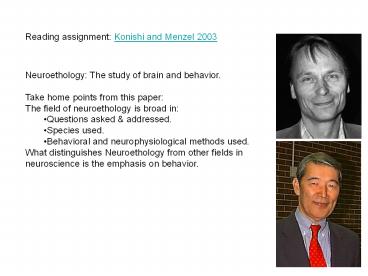Neuroethology: The study of brain and behavior. - PowerPoint PPT Presentation
1 / 15
Title:
Neuroethology: The study of brain and behavior.
Description:
Title: Slide 1 Author: Kevin C Daly Last modified by: Kevin C Daly Created Date: 8/22/2005 9:17:23 PM Document presentation format: On-screen Show Company – PowerPoint PPT presentation
Number of Views:150
Avg rating:3.0/5.0
Title: Neuroethology: The study of brain and behavior.
1
Reading assignment Konishi and Menzel 2003
- Neuroethology The study of brain and behavior.
- Take home points from this paper
- The field of neuroethology is broad in
- Questions asked addressed.
- Species used.
- Behavioral and neurophysiological methods used.
- What distinguishes Neuroethology from other
fields in neuroscience is the emphasis on
behavior.
2
- Neurons the biological basis of
- sensory input
- Sensory/memory integration
- Learning and memory
- Higher mental processes
- Production of behavior
3
Electrical properties of neurons
- Neurons are able to establish and maintain a
differential electrical charge across their
membrane (capacitance) - That differential charge is capacitance
Potential energy, or force, that drives ions to
move volts (V) - Like pressure in a fire hose.
- Based on distribution of (cations) and
(anions) - When the charge moves across the membrane, its
rate of movement is its current (I) - Water out of the hose.
- The flow of current is mediated by the overall
permeability of the membrane (resistance R ) - The hose nozzle
- The rate of flow (conductance g) is inversely
related to membrane resistance - Ohms law
- Voltagecurrent x resistance (VIxR) OR
currentconductance x voltage (IgxV) - Thus the current across a neurons membrane can be
described as the amount of electrical pressure
times the permeability of the membrane
4
- The differential charge is established by
- Electrical gradients (the force that drives and
charges together) - Concentration gradients (a process by which atoms
randomly distribute) - Active ion pumps which use ATP to move (for
example) 3 Na out for 2 K in
At rest there are 110 Na 201 K
insideoutside
5
- Currents flow through channels
- Channels are proteins that can
- Selectively or non selectively allow ions to pass
in or out of the cell. - be active
- Ligand gated
- Electrically gated
- or passive (leak channels)
Normally cell membranes intentionally but
passively leak a small amount of current
The resting state of a cell
Neurons typically maintain a resting potential of
-60 to -70mv
6
- The action potential an electrical pulse that
travels the length of the axon - Follow the links below for interactive animations
of ion currents that occur during an action
potential
http//www.psych.ualberta.ca/ITL/ap/ap.swf
http//www.blackwellpublishing.com/matthews/channe
l.html
7
- The synapse Where the impulse is passed from one
cell to another - Two basic kinds of synapses
- Electrical (gap junctions)
- Very fast
- Excitatory
- Does not require neurotransmiters
- Chemical
- Requires a neruotransmitter of some sort
- Fast (but slower than electrical)
- Can excite or inhibit
- Can modulate the permeability of a post synaptic
element for an extended period of time
8
- Types of synapses
- Axo-dendritic
- Dendro-dendritic
- Dendro-axonic
- Axo-axonic
- Dendro-somatic
- Axo-somatic
9
- The synaptic process Key events of a chemical
synapse - Action potential reaches the axon terminal where
the presynaptic element resides. - Causes the opening of CA channels.
- Ca forces the movement of microtubules onto
synaptic vesicles pressing them to the
presynaptic element. - Vesicles bind to specific sites on the
presynaptic element and open, spilling their
contents (a neurotransmitter) into the synaptic
cleft - Neurotransmitters (the ligand) bind to receptors
at specific binding sites on the post synaptic
cell membrane causing either - Deformation of the receptor protein which opens a
ion channel - Deformation of the receptor protein which
activates a second messenger (G-protein coupled
receptors). - Ultimately both mechanisms can either cause
- depolarization of the post synaptic element
(EPSP) - hyperpolarizing of the post synaptic element
(IPSP)
10
Typical excitatory vs inhibitory synaptic events
11
Synapses There not that simple
The take home message here is that a synapse is
like a tiny computational compartment!
12
G-protein coupled receptors
13
The neuromuscular junction synapse from neuron
to muscle
14
Synapses change synaptic plasticity
- Plasticity occurs for a number of reasons
- Development aging
- Experience (learning, exhaustion)
- The net result of plastic nervous systems is that
they can adapt!
15
Electrophysiology Direct method(s) for
monitoring neurons
- Intracellular (glass electrode)
- Patch electrode
- Sharp electrode
- Extracellular (wires/metals)
- Hook electrodes
- Beveled wire
- Silicon electrodes
- Examples of Indirect methods
- FMRI
- CT
- Optical immaging
- Calcium immaging

